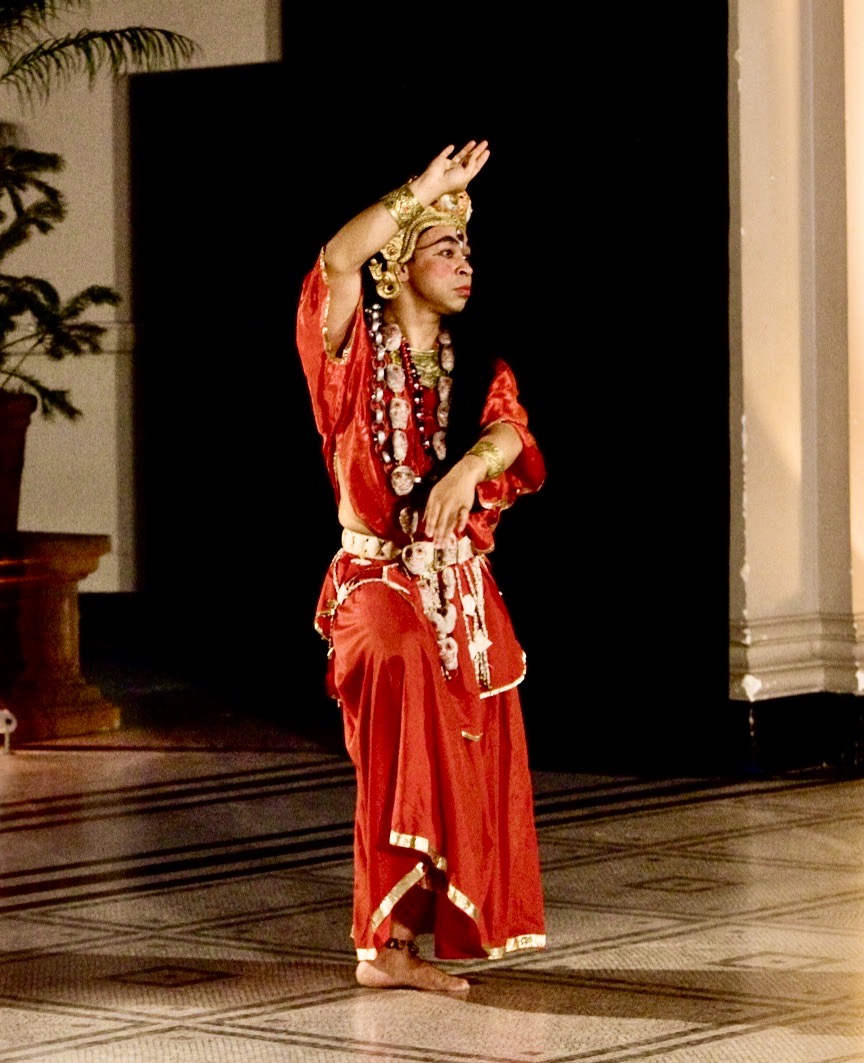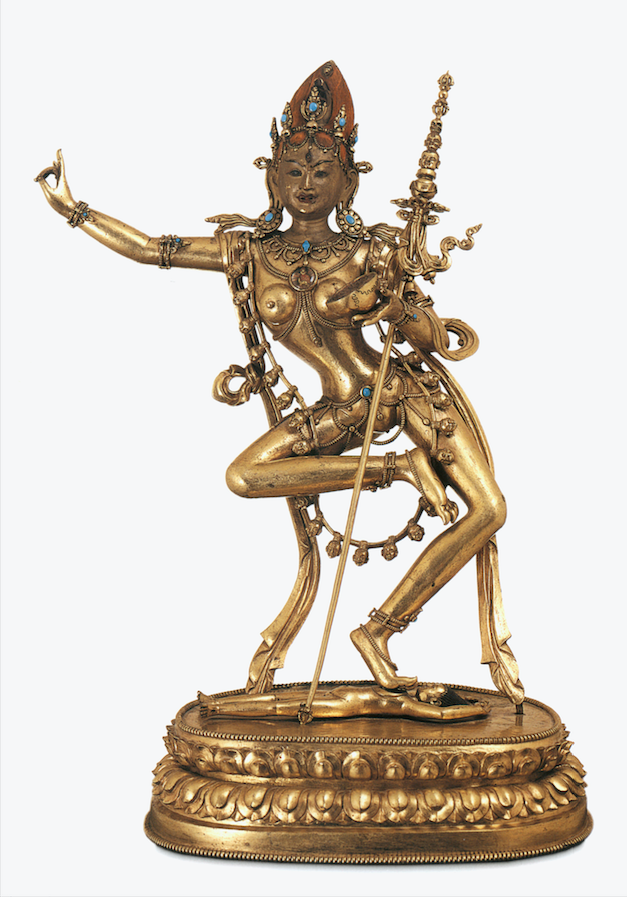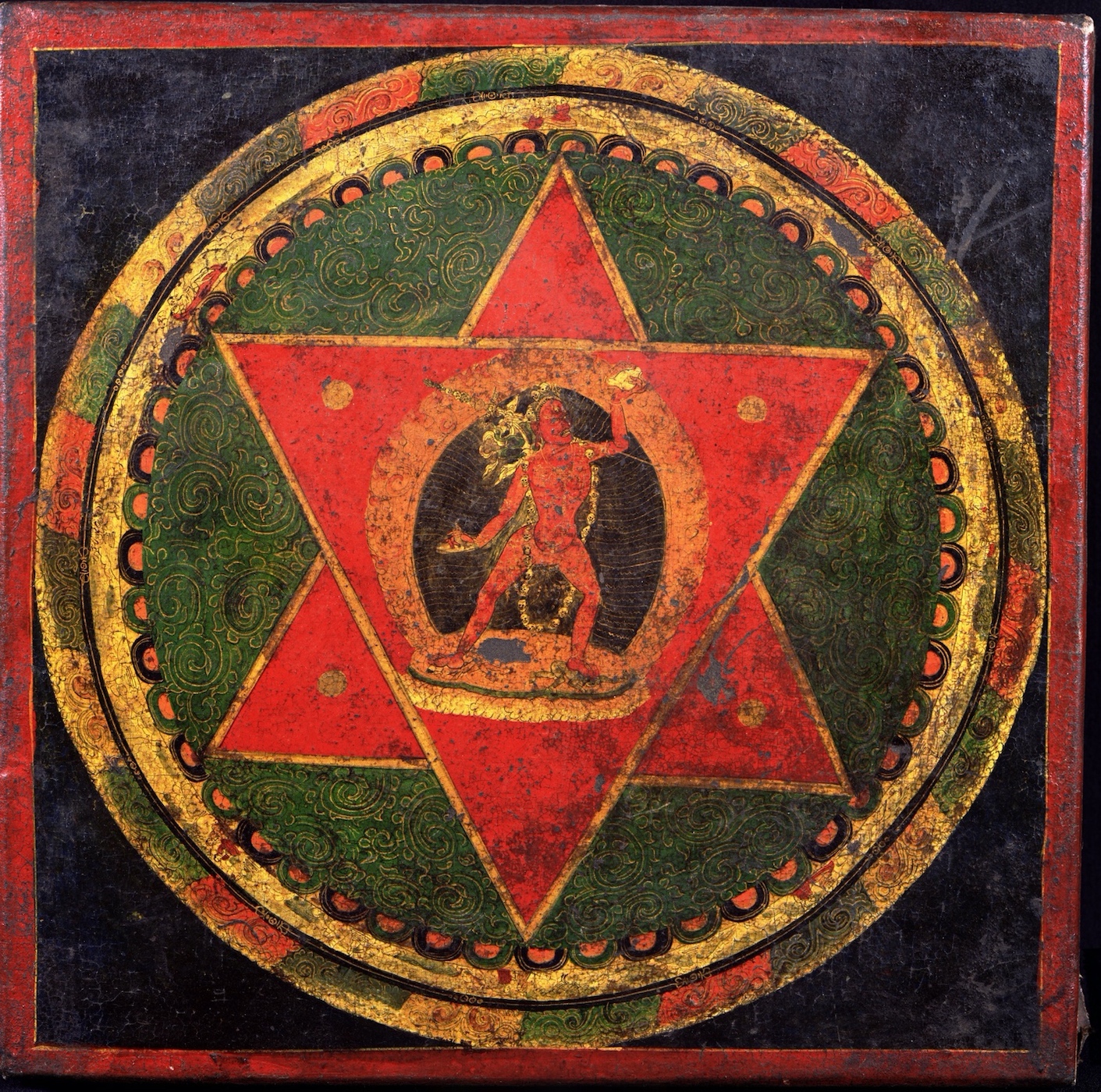FEATURES|COLUMNS|Ancient Dances
Three Aspects of Buddhist Dance

Shri Prajwal Vajracharya performs Vajrayogini in London, 2009.
Photo by Jonathan Greet. Image courtesy of Core of Culture.
This is an example of actual dance
Dance is a Western word derived from the 12th century Old French dansier, which meant, simply, to move the body in a rhythmic way. Other words for dance were derived for terms that meant “to leap,” “to jump,” and “to hop.” These words are all descriptive of the external body, the superficial form. Even an academic definition of ballet from the 1980s—“Ballet is a form with the body held as a central upright and the arms and legs moving in balance and harmony around it”—while introducing principles of balance and harmony, remains a steadfastly external description.
Problems arise because the word “dance” has become a global word for anything that moves unlike pedestrian movement: tap dance, stripper dance, liturgical dance, to name a few. In Japanese, for example, there are multiple words for dance, depending on the purpose and type of movement. The movement in Noh is called mai, which means patterning. The movement in kabuki is called buyo, which means a flourishing of arms and legs. The dances do different things and cause different effects and impacts.
In fact, many languages have more than one word for dance. It was decades after tai-chi and yoga were introduced in the West, that they began to be called tai-chi and yoga. Before that, they were called “tai-chi dance” and “yoga dance.” Even Westerners could sense that there was something categorically distinct about tai-chi and yoga that made the word “dance” ill-fitting. For one thing, the forms already had names. Most extant movement forms have names.
Buddhism has more dance than any other religion. The cultures that gave rise to Buddhism and its spread were dancing cultures in which dance was anciently established and a central part of civic, private, and spiritual life. There is no comparison with the West, except to suggest that ancient Western dances, such as those associated with Greek tragedy and the dithyramb, were gnostic in content, meaning the dance induced a level of consciousness that provided direct contact with the divine. But dance integrated at all levels of society? The West has no such thing. In Sri Lanka, by contrast, no government function occurs without traditional dance part of the occasion.
Regarding Vajrayana Buddhism and the Himalayan cultures that brokered its spread, it can be said that these cultures: Kashmir, Ladakh, India, Himachal, Nepal, and Bhutan are dancing cultures. Everyone dances, young and old. Regarding the pantheon of deities, most of which have functional roles in Tantric visualization meditation practices, there are many characters who not only dance, but always dance. Among the commonly depicted subjects of Vajrayana Buddhist art that are always shown dancing, are female spiritual energies called in Sanskrit, dakinis, and sky-heroes called in Tibetan ging, who join Black Hat sorcerers, stags, skeletons, and wrathful deities. As religious art goes, there is no religion that depicts so much dancing as Buddhism does. It is everywhere in the cultures and in the art. It is a core religious expression, being energized life itself.

Vajrayogini sculpture, Mongolian, 18th century. Metal, gold, paint, stone;
private collection. From Himalayan Art Resources.
This is an example of dance depicted
Notable in Western scholarship, when Czech linguist and Tibetologist René de Nebevsky-Wojkowitz (1923–59) observed the significance of dance to Tibetan culture, he translated the Fifth Dalai Lama’s ritual dance manual, the Chams Yig. Pioneering Italian adventurer and polymath Giuseppe Tucci, (1894–1984) was another who noticed the significance of dance in Tibetan art. He saw it as a marker of antiquity and a living symbol of order, mastery, and transmitted power. It is discussed insightfully in his greatest books. These scholars stand apart for their recognition of dance in Buddhism and Buddhist art.
In approaching Buddhist dances, we are left with the word “dance” due to its prevalence, although the efforts of many people over the past 20 years to call tantric Buddhist cham, “cham,” instead of "sacred Buddhist dance” have paid off. Many people now know what cham is, what it looks like, and a growing number of people realize that cham is in fact a Buddhist deity yoga, not a dance in the Western sense. One reason that tourism can inflict a negative impact on Buddhist ritual expression is that the tourists don’t understand what they are seeing, and the result is disrespectful behavior. Basically, Westerners understand dance as socializing and entertainment.
Performance anthropologist Joan Erdman offered three terms that are very helpful in appreciating essential aspects of dance in Buddhism: dance actual, dance depicted, and dance ephemeral. When Buddhist dance is seen to manifest in each of these realms, its full potency as a medium of religion and spiritual practice becomes clearer.
Dance actual refers to what we normally call dancing: physical bodies moving in space according to a specific order and form. It is plain dancing. Seeing masked monks performing danced mandalas in a courtyard is actual dancing. It has to be learned, mastered, and then performed. There is a lot of actual dancing in Buddhist practices.
Dance depicted refers to dancing images in Buddhist art, painting, sculpture, murals, and illustrated manuscripts. Meditation deity Vajrayogini in a thangka painting is dance depicted. A mural showing wrathful deities in erotic embrace moving rhythmically with their consorts, is dance depicted. A sculpture of Vajrayogini, on her toes, shifting from one form to another, is dance depicted. There is a lot of dance imagery depicted in Buddhist art.
Dance ephemeral refers to disembodied dance, such as in a monastic meditation visualization, or the practice of a yidam deity for personal meditation. The disembodied dance allows the meditator to embody a deity, something fundamental to deity yoga. By first becoming empty, and replacing the emptiness with a visualized deity, the meditator creates a mandala within themselves that is discarded as simply as pouring away a sand mandala in a river. It is all activity of emptiness; of the Sambhogakaya, the illusory world. In tantric sorcery, dancing entities are conjured and given instructions to carry out. The practices include making a visualized deity dance.
In practice, these aspects interact. The relationships of dance ephemeral, such as in deity visualization, is often assisted by dance depicted in the form of a painted thangka, or in the murals and reliefs of a meditation hall, where groups of monks carry out collective rituals. In the case of cham, the monks are highly trained. The “dance ephemeral” as a visualization meditation is assisted by the “dance depicted” in art used for the rituals, and culminates in the fully fledged “dance actual”: the large public ceremonies of masked dance.
Buddhist dance can be understood as something multi-dimensional, transformative, and consciousness-altering. By understanding these three aspects of Buddhist dance—actual, depicted, and ephemeral—its full meaning is easier to grasp and the reason for its prominence in art makes more sense. Placing dance in a mandala: depicted, visualized, or actualized, further strengthens the correspondence between dance and the practice of mystical Buddhism.

Vajrayogini Mandala. Tibet, 18th century. Pigment, gold, and wood. This mandala is used
for Vajrayogini visualization meditation according to the tradition of Naropa.
Rubin Museum Collection. From Himalayan Art Resources.
This is an example of the dance visualization tradition, or dance ephemeral, in reference
to the visualized deity, not the painting, which is another example of dance depicted.
The connection between dance depicted and dance visualized is clear
See more
Related features from Buddhistdoor Global
Mongolia’s Hope: Baasansuren Khadsuren, the Singing Abbot of Erdene Zuu
The Blessings of White Tara Beyond Time and Space
A Reflection on the Robert Ho Symposium: Bridging the Inner and Outer Divides
A Conversation with Mongolian Yogini Kunze Chimed on Her New Book: Lujin
Giuseppe Tucci, an Orgiastic Aha! Part One
Related news from Buddhistdoor Global
Asian Buddhist Conference for Peace Marks 50th Anniversary in Mongolia
Fourth International Conference of Buddhist Women Held in Mongolia
Challenges Ahead for Millennial Monks Revitalizing Mongolia’s Ancient Buddhist Tradition














